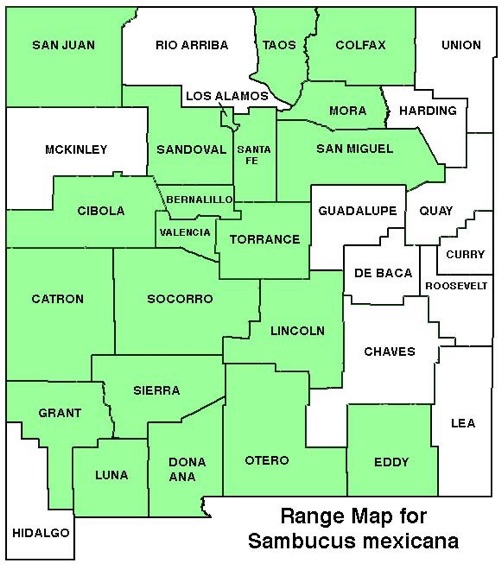WILDFLOWERS OF NEW MEXICO

With showy flowers and nutritious fruit, this favorite of pollinators and animals can be an upright, 6–26 feet tall (2–8 m) multi-branched shrub or a small tree. Note the pinnate leaves with toothed leaflets, flat-topped clusters of small, white flowers, and small blue berries. The berries are considered edible when cooked. Numerous cultivars are used in landscaping.
FLOWERS: June–September. Flat-topped clusters 2–12 inches wide (5–30 cm); flowers creamy white; fruit round, fleshy, 1/4 inch wide, (6 mm), dark-blue with a powdery, white coating.
LEAVES: Opposite; blades 5–7 inches long (13–18 cm), pinnate with 5–9 leaflets, each lance-shaped to elliptic, 1–5 inches long (3–13 cm) by 3/8–2 3/8 inches wide (1–6 cm); edges serrated; top surface smooth; bottom pale, smooth to sparsely hairy; tips pointed.
HABITAT: Stream sides, moist woods, slopes, drainages, disturbed areas; pinyon-juniper foothills, ponderosa-Douglas fir, spruce-fir forests.
ELEVATION: 3,700–11,400 feet (1128–3475 m).
RANGE: Widespread in every state and Canada.
SIMILAR SPECIES: The scientific nomenclature used here follows the most up to date classification used in Flora Neomexicana III (Allred, 2020). Various sources have placed Blue Elderberry in 3 different families and given it 6 different species names with various subspecies and variety divisions.
NM COUNTIES: Widespread in foothills and mountains in NM in mid-to high-elevation, moist habitats: Bernalillo, Catron, Cibola, Colfax, Dona Ana, Eddy, Grant, Lincoln, Los Alamos, Luna, Mora, Otero, San Juan, San Miguel, Sandoval, Santa Fe, Sierra, Socorro, Taos, Torrance, Valencia.









BLUE ELDERBERRY
SAMBUCUS MEXICANA (S. cerulea, S. nigra subsp. cerulea )
Viburnum Family, Viburnaceae
Deciduous shrub, small tree


















THE CONTENTS OF THIS WEBSITE ARE COPYRIGHTED AND CANNOT BE USED
WITHOUT PERMISSION OF GEORGE OXFORD MILLER
















EMAIL ME













































Flowers have 5 tiny, spreading petals.
Leaflet edges are lined with serrated teeth.

Purple fruit have a powdery white covering.
Fruit ripen in large, flat-topped clusters.
Blue elderberry can grow as a small tree or bushy shrub.
















